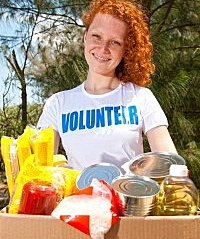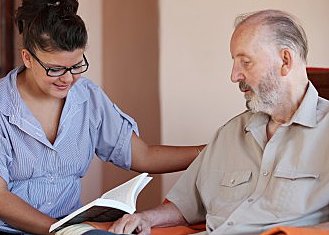 Community service is the act of volunteering toward a cause or service for a particular community, and it can be a rewarding and humbling experience. The United States Bureau of Labor Statistics reported that about 64.3 million people volunteered via an organization at least once between September 2010 and September 2011. Community service can apply toward a wide variety of efforts, such as helping those in need by supplying food, water, or shelter, fundraising for a common cause, partaking in environmental care or clean-up, teaching, or general outreach. Volunteering in America‘s surveys have suggested that self-organized ‘do-it-yourself’ services have been most popular during the recession, a trend president Obama promoted with his United We Serve initiative. It might seem counter-intuitive that community service has surged during a time of economic collapse, but people continue to donate their time and give charitably, perhaps sensing that the United States needs volunteering the most in a market with dwindling resources.
Community service is the act of volunteering toward a cause or service for a particular community, and it can be a rewarding and humbling experience. The United States Bureau of Labor Statistics reported that about 64.3 million people volunteered via an organization at least once between September 2010 and September 2011. Community service can apply toward a wide variety of efforts, such as helping those in need by supplying food, water, or shelter, fundraising for a common cause, partaking in environmental care or clean-up, teaching, or general outreach. Volunteering in America‘s surveys have suggested that self-organized ‘do-it-yourself’ services have been most popular during the recession, a trend president Obama promoted with his United We Serve initiative. It might seem counter-intuitive that community service has surged during a time of economic collapse, but people continue to donate their time and give charitably, perhaps sensing that the United States needs volunteering the most in a market with dwindling resources.
Motives for Volunteering
Although young people tend to be the smallest demographic portrayed in community service efforts, volunteering when you’re young is a wise choice not only for the benefit of the community but also for personal gain. It’s not necessarily a bad thing to volunteer with some of your own motivations in mind, even though community service is often stereotyped as a selfless act. You may be volunteering in an effort to perfect a particular skill, such as leadership ability. It may fulfill an academic credit. You may be volunteering for a political cause you believe in, knowing that your presence can help initiate change. Universities appreciate a well-rounded student with a penchant for helping out in their community. Experience with community service could give you the edge you need to compete with your peers, gaining acceptance into a particular college or other organization.
Some volunteer because they feel a sense of gratification for changing their community for the better. Making a difference to improve the lives of others, propagating a cause they believe in, or networking among likeminded people can be mutually satisfying for the volunteer and the recipients of the service. Community service provides another social circle for the volunteer. It also has its proven health benefits. Volunteers have a lower mortality rate, function better, and tend to be less depressed than those who do not volunteer, according to the Corporation for National and Community Service. Volunteering gives one a sense of purpose and the feel-good factor of it reflects positively on our actual health state.
There are also those that volunteer for more complicated reasons. Undertaking community service can be an enriching experience, making one aware of the continual need for help around the world. Working among those in need humbles the volunteer. They may participate in community service for religious reasons, out of guilt, because it’s therapeutic to them, or in order to feel challenged. They may simply enjoy working because they’re among friends. They may have even been assigned community service as a means of punishment for a crime. The reasons vary from person to person, but regardless of the motive, volunteering efforts are needed and appreciated every day. Community service helps benefit the community in critical ways, even if it isn’t propelled by altruism. Still, there are those that gain valuable insight from community service and experience personal growth. Many colleges value community service to this end, hoping to recruit a school of students with the ability to positively impact the world.
Who Benefits?
Community service can benefit an array of different people or causes.
Likewise, the American Society for the Prevention of Cruelty to Animals, or the ASPCA is a humane organization that “works to rescue animals from abuse, pass humane laws and share resources with shelters nationwide.” With shelters across the country, they thrive through monthly donations and help from their volunteers. Using volunteer work at the ASPCA as part of your community service can give you a myriad of options, as they are in constant need of assistance. Just some of the ways you could help out include transporting animals to and from the shelter, holding fundraisers in their name, assisting in animal adoption, cleaning cages, walking the dogs, foster care, and training. All donations go toward housing the animals, tending to their medical needs, and food. Some of the shelters are no-kill shelters, which means that overcrowding can be an issue. All volunteers provide a valuable service of keeping the operation going and helping sometimes neglected, helpless animals get into happy, loving homes.
In guerilla gardening, the environment and the people who cherish it benefit. Guerilla gardening is a fairly recent trend and somewhat of an avant-garde form of community service. It is less of an organization and more of a do-it-yourself initiative, in which everyday members of the community garden in public places with or without permission for the betterment of the landscape. Some guerilla gardeners participate in “seed bombing,” in which they form wads of dirt, seeds, clay, compost, and water and scatter the bombs in decrepit areas throughout the city. The guerilla gardener seeks areas that could be used for growth, but are instead left for neglect, benefiting nobody. They then infiltrate it with flora, fauna, and even fruits and veggies for human consumption. Some may regard it as radical, bordering on civil disobedience, while others see it as bettering the community by returning life to otherwise useless areas.
The Washington Post interviewed 25-year-old Emmy Gran, a guerilla gardener who is teaching seed-bombing workshops in Shaw, Washington. At the end of every guerilla gardening spree, Shaw graffitis the walls with a moss mixture, created by combining moss, a half teaspoon of sugar, and beer or yogurt in a blender. She gardens for “food justice” and to make the community more beautiful, but notes that it can feel somewhat deviant. “If you see an abandoned, neglected lot and you decide to do something about it by planting vegetables and herbs, are you an occupier?” Gran dwells.
Volunteering Your Way into College
In terms of utilizing your community service credentials to get into a good college, the earlier you start volunteering, the better. College applications will address your community service experience and you will be required to list specific examples. Likewise, many college essays are geared toward enriching experiences, such as travel or community service efforts, hoping to extrapolate some of the self-nurturing qualities that came along with such moments in your life. If you partook in community service in junior high and high school, you will likely stand out more than another applicant that chose not to participate in community service. It sets you apart as being a compassionate, mature individual, traits most colleges highly prefer in their collegiate body. A U.S. News article touches on the importance of community service work for college applications. Nancy Lublin of DoSomething.org, an organization that helps teens to promote causes that are important to them, notes that while participating in community service in general used to be an invaluable trait, college admissions teams are now becoming even more specific, looking for students that have demonstrated a commitment to one particular community service. By consistently supporting the same volunteer effort, students “show commitment and perseverance, both of which are stellar traits for potential co-eds.”
DoSomething.org has released a survey for the past three years in which they interview admissions officers from top universities to see the number of schools that prefer to select students with experience in volunteering. This past year’s survey reflected that 72% of the 32 schools participating in the survey desired students that were consistently involved with one community service effort. However, there is a balance. Fifty-two percent believe that a student can have too many service hours, showing that they are less rounded than some students who undertake community service alongside extracurricular sports activities, involvement in student council, or the school newspaper. A student who is so focused on community service that they have time for nothing else is not as desirable as a student who can balance many responsibilities at once, with equal commitment to each.
Schools with an Eye for Community Service
 If a college values community service at the University itself, it likely takes note of community service experience in its applicants. Many major universities encourage their students to partake in community service activities and in some colleges it is even built into the system. For example, Eastern Connecticut State University requires four hours of community service simply to acquire a dorm room, according to an article posted in The New York Times. The students aren’t given the choice of whether or not to give their time. If all 5,586 of 2011’s fall enrollments completed the minimum amount of community service hours required to obtain a dorm room, it equates to an excess of 22,000 hours of community service.
If a college values community service at the University itself, it likely takes note of community service experience in its applicants. Many major universities encourage their students to partake in community service activities and in some colleges it is even built into the system. For example, Eastern Connecticut State University requires four hours of community service simply to acquire a dorm room, according to an article posted in The New York Times. The students aren’t given the choice of whether or not to give their time. If all 5,586 of 2011’s fall enrollments completed the minimum amount of community service hours required to obtain a dorm room, it equates to an excess of 22,000 hours of community service.
An article in Washington Monthly notes that University of California-Riverside grants 51% of its work study funds to community service programs, rendering it the top public school for community service. The top private school for community service is Florida Memorial College, utilizing 59.2% of its federal work study funds toward community service. If you’re applying for any of these schools, you should figure volunteer work into your college application. The schools have already identified themselves as being strong supporters of philanthropic activity.
Scholarships You Can Get
If you volunteer early in life, not only can you pad your college application with your impressive community service dedication, but you might also be eligible for a variety of scholarships awarded to young volunteers across the country. The Prudential Spirit of the Community Award grants two middle and high school winners from each state with a $1,000 award and a trip to Washington, D.C. The ten national winners then receive $5,000 in scholarship funds and $5,000 toward their chosen charity. The awards are given solely based on the individual’s efforts in community service. Thus, being a volunteer can help you pay your way through college.
Likewise, the Kohl’s Cares Scholarship Program is applicable to any volunteer between the ages of six and 18 that hasn’t graduated high school. The student’s community service efforts will be gauged and then awarded, with the national winners receiving $10,000 in scholarships for post-secondary education and an additional $1,000 toward a non-profit organization. Over 2,200 kids are awarded in store, regional, and national levels with over $420,000 dedicated toward scholarships and prizes.
If you still enjoy community service and hope to continue with it after graduating college, you can pursue the National Grid’s Huntington Public Service Award, a scholarship opportunity that grants one lucky individual with a $10,000 stipend to spend a year volunteering their services. The applicant must write a proposal concerning the community service they wish to enact, which can be held both within the United States and abroad, giving the winner some exciting opportunities. They may choose to volunteer on an individual basis or through established charitable, religious, educational, governmental, and other public service organizations. Previous winners have done volunteer work in places like Ecuador, Cambodia, Kenya, India, and Chile.

 Rich Kiker is the Director of Online Learning at a K-12 school district in Pennsylvania, a blogger, an online professor, and a Google Certified Apps for Education Trainer. Other consulting roles include eLearning design, social learning, technology pathways development, and 1 to 1 computing. He can be reached at
Rich Kiker is the Director of Online Learning at a K-12 school district in Pennsylvania, a blogger, an online professor, and a Google Certified Apps for Education Trainer. Other consulting roles include eLearning design, social learning, technology pathways development, and 1 to 1 computing. He can be reached at 